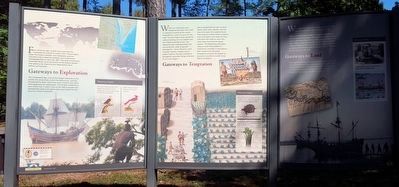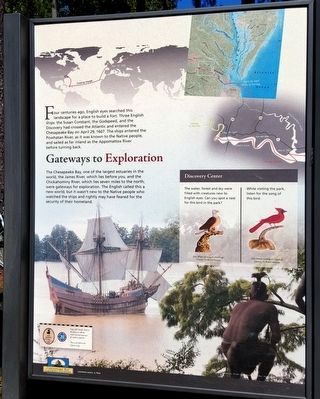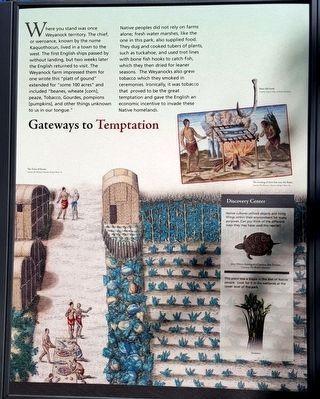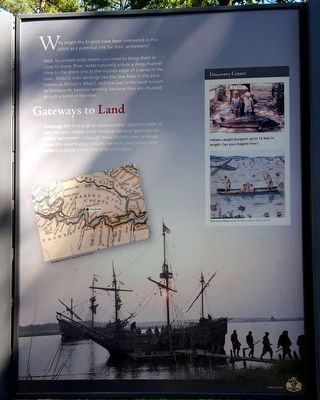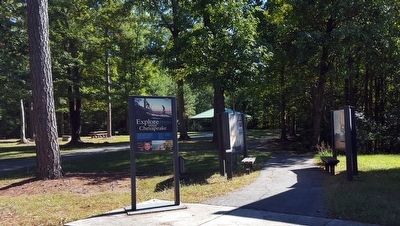Charles City in Charles City County, Virginia — The American South (Mid-Atlantic)
Captain John Smith’s Trail on the James
South Panel
Inscription.
(left panel)
Gateways to Exploration
Four centuries ago, English eyes searched this landscape for a place to build a fort. Three English ships: the Susan Constant, the Godspeed, and the Discovery had crossed the Atlantic and entered the Chesapeake Bay on April 29, 1607. The ships entered the Powhatan River, as it was known to the Native people, and sailed as far inland as the Appomattox River before turning back.
The Chesapeake Bay, one of the largest estuaries in the world, the James River, which lies before you, and the Chickahominy River, which lies seven miles to the north, were gateways for exploration. The English called this a new world, but it wasn't new to the Native people who watched the ships and rightly may have feared for the security of their homeland.
Discovery Center
The water, forest and sky were filled with creatures new to English eyes. Can you spot a nest for this bird in the park?
John White’s drawing of a Bald Eagle. Courtesy The British Museum.
While visiting the park, listen for the song of this bird.
John White’s drawing of a Cardinal. Courtesy The British Museum.
(sidebar)
Caption John Smith’s Trail on the James is a 40-site water trail and auto tour for modern explorers.
This is site #20 on the Cypress Loop.
(captions)
“The New World” MMV New Line Productions, Inc. All rights reserved. Photo by Marie Wallace. Photo courtesy of New Line Productions, Inc.
(center panel)
Gateways to Temptation
Where you stand was once Weyanock territory. The chief, or weroance, known by the name Kaquothocun, lived in a town to the west. The first English ship passed by without landing, but two weeks later the English returned to visit. The Weyanock farm impressed them for one wrote this "platt of gound” extended for “some 100 acres” and included “beanes, wheate [corn], peaze, Tobacco, Gourdes, pompions [pumpkins], and other things unknown to us in our tongue.”
Native peoples did not rely on farms alone; fresh water marshes, like the one in this park, also supplied food. They dug and cooked tubers of plants, such as tuckahoe, and used trot lines with bone fish hooks to catch fish, which they then dried for leaner seasons. The Weyanocks also grew tobacco which they smoked in ceremonies. Ironically, it was tobacco that proved to be the great temptation and gave the English an economic incentive to invade these Native homelands.
Discovery Center
Native cultures utilized objects and living things within their environment for many purposes. Can you think of the different ways they may have used this reptile?
John White’s drawing of a Common Box Tortoise. Courtesy The British Museum.
This plant was a staple in the diet of Native people. Look for it in the wetlands at the lower level of this park.
Tuckahoe
(captions)
The Town of Secota Courtesy The Mariners’ Museum, Newport News, Va.
Bone fish hook. Courtesy Virginia Dept. of Historic Resources
The broiling of their fish over the flame. Courtesy The Mariners’ Museum, Newport News, Va.
(right panel)
Gateways to Land
Why might the English have been interested in this place as a potential site for their settlement?
Well, to unload large vessels you need to bring them in close to shore. River water naturally scours a deep channel close to the shore line at the outside edge of a bend in the river. Historic river landings like the one here in the park known as Wilcox’s Wharf, and one just to the west known as Swineyards, became landings because they are situated at such a bend in the river.
Although the first English chose another place to settle, it was not long before these landings became gateways to inland settlements. Through these historic river landings came the adventurers, settlers, servants, and slaves who helped to forge a new and different nation.
Discovery Center
Indians caught sturgeon up to 12 feet in length. Can you imagine how?
Their manner of fishing. Courtesy The Mariners’ Museum, Newport News, Va.
(captions)
Fry-Jefferson map 1751. Courtesy The Library of Virginia.
“The New World” MMV New Line Productions, Inc. All rights reserved. Photo by Marie Wallace. Photo courtesy of New Line Productions, Inc.
Erected by Chesapeake Bay Gateways Network, Charles City County, Lawrence Lewis Jr. Park. (Marker Number 20.)
Topics. This historical marker is listed in these topic lists: Colonial Era • Exploration • Native Americans • Settlements & Settlers. A significant historical date for this entry is April 29, 1607.
Location. 37° 19.164′ N, 77° 5.941′ W. Marker is in Charles City, Virginia, in Charles City County. Marker is on Wilcox Wharf Road, one mile John Tyler Memorial Highway (Virginia Route 5), on the right when traveling south. Located in Lawrence Lewis Jr. Park. Touch for map. Marker is at or near this postal address: 12400 Wilcox Wharf Road, Charles City VA 23030, United States of America. Touch for directions.
Other nearby markers. At least 8 other markers are within 3 miles of this marker, measured as the crow flies. A different marker also named Captain John Smith’s Trail on the James (here, next to this marker); John Smith Explores the Chesapeake (approx. 0.2 miles away); Wilcox’s Landing (approx. 0.2 miles away); Swineyards - Willcox Wharf (approx. one mile away); Grant's Crossing (approx. one mile away); John Tyler's Birthplace (approx. 1.7 miles away); Eye Witness to a Revolution (approx. 2.1 miles away); Shifting Ground (approx. 2.1 miles away). Touch for a list and map of all markers in Charles City.
Also see . . .
1. Chesapeake Explorer. National Park Service (Submitted on October 12, 2015.)
2. Captain John Smith Chesapeake National Historic Trail. National Park Service (Submitted on October 12, 2015.)
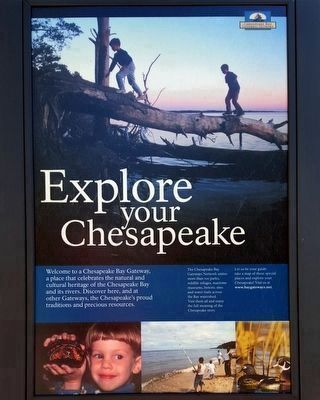
Photographed By Bernard Fisher, October 11, 2015
6. Explore your Chesapeake Marker
Welcome to a Chesapeake Bay Gateway, Gateways Network a place that celebrates the natural and cultural heritage of the Chesapeake Bay and its rivers. Discover here, and at other Gateways, the Chesapeake's proud traditions and precious resources.
The Chesapeake Bay Gateways Network unites more than 100 parks, wildlife refuges, maritime museums, historic sites and water trails across the Bay watershed. Visit them all and enjoy the full meaning of the Chesapeake story.
Let us be your guide: take a map of these special places and explore your Chesapeake! Visit us at www.baygateways.net.
The Chesapeake Bay Gateways Network unites more than 100 parks, wildlife refuges, maritime museums, historic sites and water trails across the Bay watershed. Visit them all and enjoy the full meaning of the Chesapeake story.
Let us be your guide: take a map of these special places and explore your Chesapeake! Visit us at www.baygateways.net.
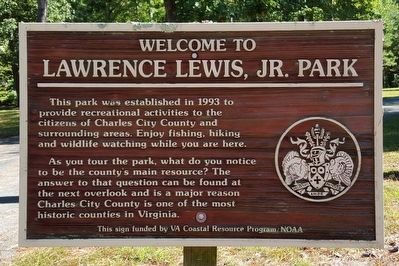
Photographed By Bernard Fisher, October 11, 2015
7. Welcome to Lawrence Lewis, Jr. Park
This park was established in 1993 to provide recreational activities to the citizens of Charles City County and surrounding areas. Enjoy fishing, hiking and wildlife watching while you are here.
As you tour the park, what do you notice to be the county's main resource? The answer to that question can be found at the next overlook and is a major reason Charles City County is one of the most historic counties in Virginia.
This sign funded by VA Coastal Resource Program/NOAA
Credits. This page was last revised on June 16, 2016. It was originally submitted on October 12, 2015, by Bernard Fisher of Richmond, Virginia. This page has been viewed 456 times since then and 21 times this year. Photos: 1, 2, 3, 4, 5, 6, 7. submitted on October 12, 2015, by Bernard Fisher of Richmond, Virginia.
